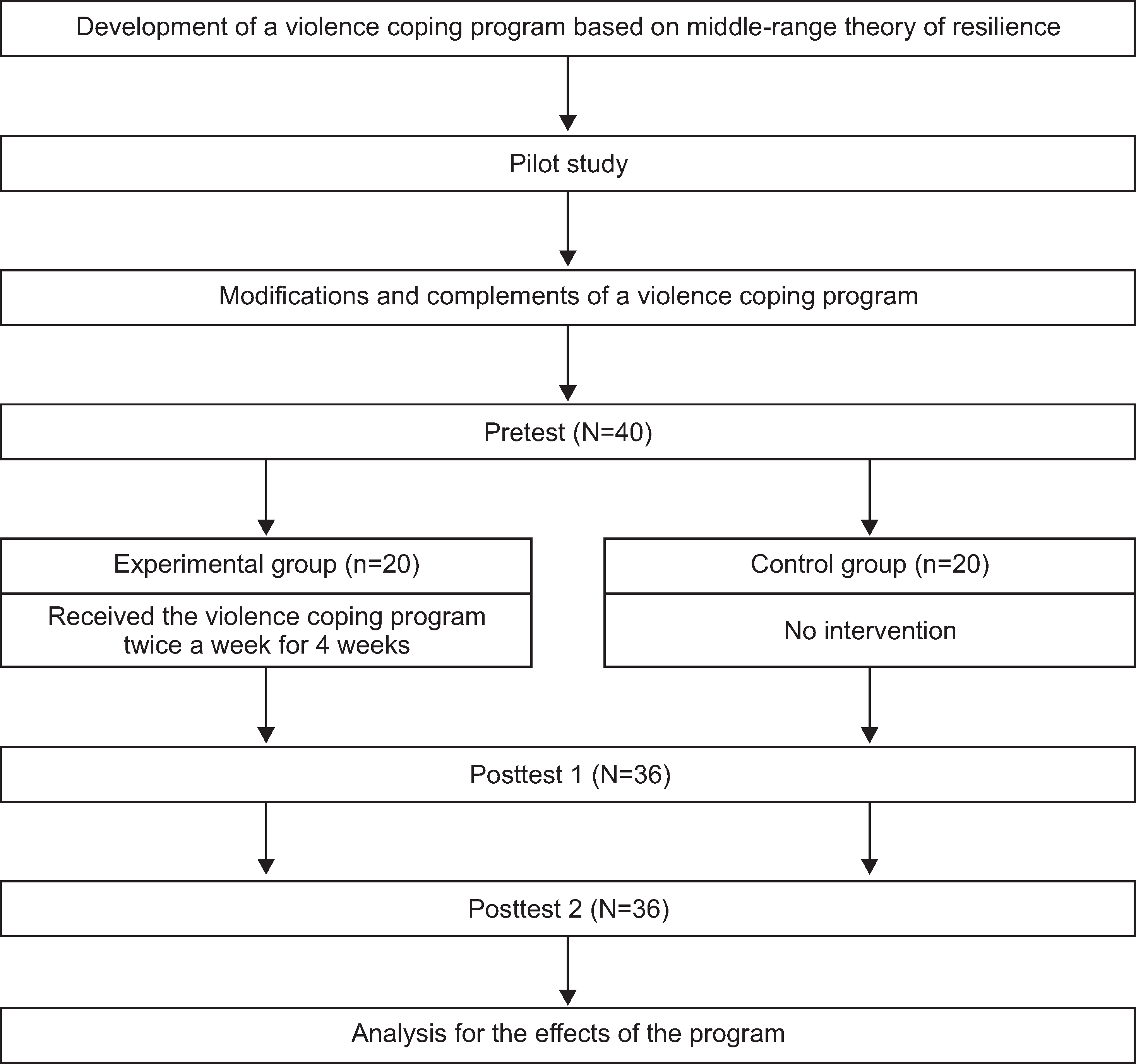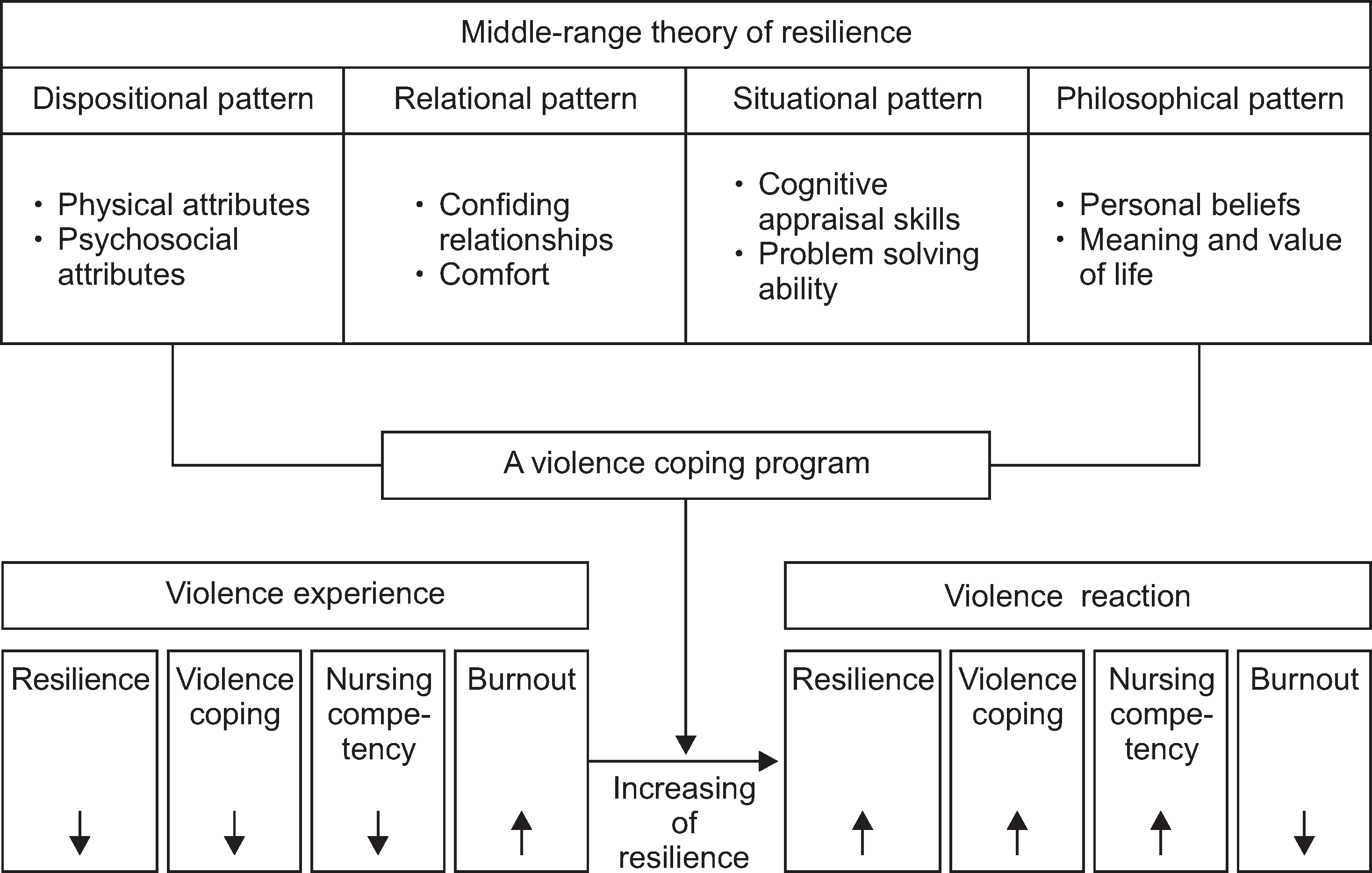Abstract
Purpose
The purpose of this study was to examine the effects of a violence coping program (VCP) based on Polk's middle-range theory of resilience on nursing competency, resilience, burnout, and the ability to cope with violence in nurses working in emergency rooms.
Methods
A quasi-experimental study, with a nonequivalent control group and a pretest-posttest design, was conducted. Participants were 36 nurses who worked in emergency rooms and had experienced violence; 18 nurses from D hospital and 18 nurses from C hospital were assigned to the experimental and control groups, respectively. The experimental group received the VCP twice per week for 8 weeks.
Go to : 
References
1. Park E, Kang SJ, Lee EK, Ji EJ, Kang RH, Paik CH. Violence experience of clinical nurse in the hospital. Journal of Korean Clinical Nursing Research. 2001; 7(2):187–202.
2. Kim SY, Eom M, Oh HY, Ahn HY. Violence episodes and responses of emergency room nurses. Journal of Korean Academy of Fundamentals of Nursing. 2007; 14(4):446–456.
3. Normandale S, Davies J. Bullying at work. Community Practitioner. 2002; 75:474–477.
4. Gorkin M. The four stages of burnout. Journal of Additional information. 2004; 83(4):24–4.
5. Yang JH, Jung HY. Relationship between violence response, coping, and burnout among emergency department nurses. Journal of Korean Academy of Fundamentals of Nursing. 2009; 16(1):103–111.
6. Sung MH. Relationship of the experience of violence to burnout and job satisfaction in emergency department nurses. Journal of Korean Clinical Nursing Research. 2008; 14(2):83–92.
7. Jackson D, Firtko A, Edenborough M. Personal resilience as a strategy for surviving and thriving in the face of workplace adversity: A literature review. Journal of Advanced Nursing. 2007; 60(1):1–9. http://dx.doi.org/10.1111/j.1365-2648.2007.04412.x.

8. Tusaie K, Dyer J. Resilience: A historical review of the construct. Holistic Nursing Practice. 2004; 18(1):3–8. quiz 9-10.
9. Park MM, Park JW. Development of resilience scale for nurses. Journal of Korean Academy of Fundamentals of Nursing. 2016; 23(1):32–41. http://dx.doi.org/10.7739/jkafn.2016.23.1.32.

10. Lee AS, Yoon CK, Park JK. Effects of social support and ego-resilience on nursing performance of hospital nurses. Korean Journal of Occupational Health Nursing. 2012; 21(3):283–289. http://dx.doi.org/10.5807/kjohn.2012.21.3.283.

11. Kang HH. Relationship between social capital of sports voucher, ego-resilience, and perception of empowerment of adolescent in the low-status. Korean Journal of Sports Science. 2013; 22(5):491–507.
12. Park YJ, Lee EJ. A study on ego-resilience, disaster experience and core competencies among emergency room nurses. Journal of Korean Clinical Nursing Research. 2015; 21(1):67–79. http://dx.doi.org/10.22650/JKCNR.2015.21.1.67.
13. Jang KS. A study on establishment of clinical career development model of nurses [dissertation]. Seoul: Yonsei Unversity;2000. p. 1–201.
14. Polk LV. Toward a middle-range theory of resilience. ANS Advances in Nursing Science. 1997; 19(3):1–13. http://dx.doi.org/10.1097/00012272-199703000-00002.

15. Kim JC, Seol YM, Song HS. Survey of emergency department violence. Journal of the Korean Society of Emergency Medicine. 2003; 14(3):309–313.
16. Park JK, You YH, Park JS, Park SS, Chung SP, Kim SW, et al. Current status of violence in the emergency centers: Frequency and management. Journal of the Korean Society of Emergency Medicine. 2004; 15(6):575–579.
17. Hyun MS, Cho HJ, Lee MA. Effect of SBAR-collaborative communication program on the nurses’ communication skills and the collaboration between nurses and doctors. Journal of Korean Academy of Nursing Administration. 2016; 22(5):518–530. http://dx.doi.org/10.11111/jkana.2016.22.5.518.

18. Waltz CF, Bausell RB. Nursing research: Design, statistics, and computer analysis. Philadelphia, PA: F. A. Davis Co.;1981. p. 39–100.
19. Choi WJ, Cho SH, Cho NS, Kim GS. Effect of an education program on violence in the emergency department. Journal of the Korean Society of Emergency Medicine. 2005; 16(2):221–228.
20. Lee EO, Lim NY, Park HA. Nursing research and statistics. Paju: Soomoonsa;1998. p. 378–384.
21. Kim SJ, Choi MS, Sung KW. Variables affecting competency of nurses in nursing homes. Journal of Korean Gerontological Nursing. 2010; 12(1):29–39.
22. Maslach C, Jackson SE. The measurement of experienced burnout. Journal of Organizational Behavior. 1981; 2(2):99–113. http://dx.doi.org/10.1002/job.4030020205.

23. Choi HY, Chung NW. Perfectionism tendency, social support, and burnout among counselors. The Korean Journal of Health Psychology. 2003; 8(2):279–300.
24. Choi SO, Cho SY. The development and effect analysis of a laughter therapy program to improve the self-esteem and stress-coping skills of children using a community children’s center. Korean Journal of Family Welfare. 2011; 16(4):97–117.
25. DiPietro F. Vicarious trauma and compassion fatigue in battered women’s advocates: A secondary prevention program [dissertation]. West Hartford, CT: University of Hartford;2005. p. 1–202.
26. McDonald G, Jackson D, Wilkes L, Vickers MH. A work-based educational intervention to support the development of personal resilience in nurses and midwives. Nurse Education Today. 2012; 32(4):378–384. http://dx.doi.org/10.1016/j.nedt.2011.04.012.

27. Chang KM. The relations of ego-resiliency, stress coping style, and psychological growth environment. Korean Journal of Youth Studies. 2003; 10(4):143–161.
28. Wagnild GM, Young HM. Development and psychometric evaluation of the resilience scale. Journal of Nursing Measurement. 1993; 1(2):165–178.
29. Parry SR. The question for competencies. Training and Development Journal. 1996; 33(7):48–56.
30. Park HW. The effect of laughter therapy program on mental health. The Korean Journal of Stress Research. 2010; 18(3):287–294.
Go to : 
Table 1.
Content of the Violence Coping Program
Table 2.
Homogeneity Tests for Subject’s Characteristics and Study Variables (N=36)
Table 3.
Effects of the Violence Coping Program in Emergency Room Nurses (N=36)




 PDF
PDF ePub
ePub Citation
Citation Print
Print




 XML Download
XML Download